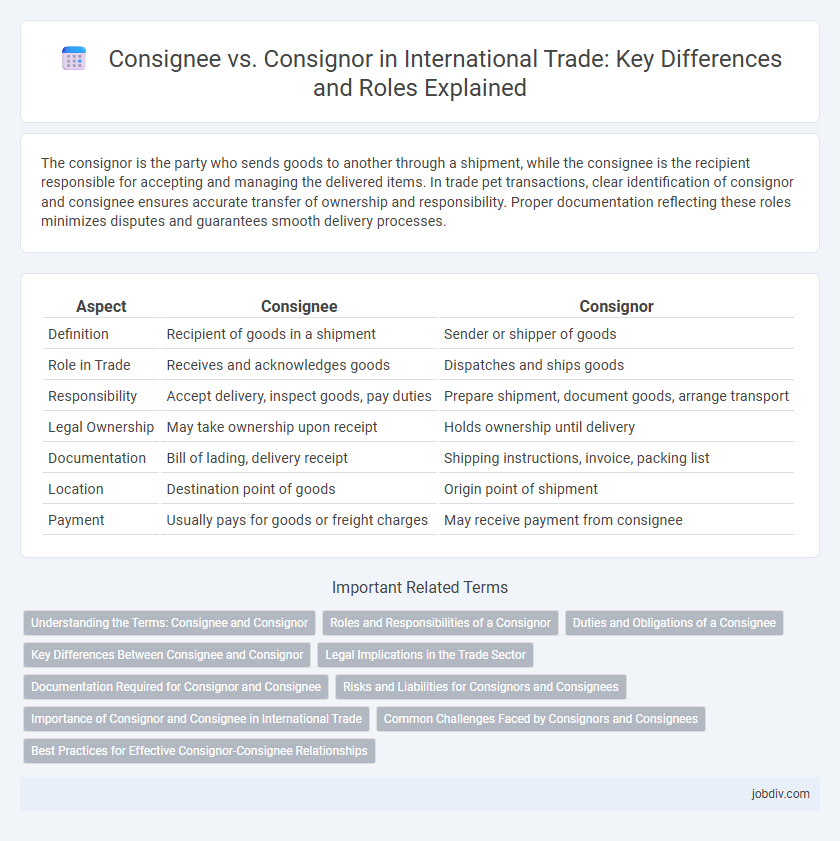The consignor is the party who sends goods to another through a shipment, while the consignee is the recipient responsible for accepting and managing the delivered items. In trade pet transactions, clear identification of consignor and consignee ensures accurate transfer of ownership and responsibility. Proper documentation reflecting these roles minimizes disputes and guarantees smooth delivery processes.
Table of Comparison
| Aspect | Consignee | Consignor |
|---|---|---|
| Definition | Recipient of goods in a shipment | Sender or shipper of goods |
| Role in Trade | Receives and acknowledges goods | Dispatches and ships goods |
| Responsibility | Accept delivery, inspect goods, pay duties | Prepare shipment, document goods, arrange transport |
| Legal Ownership | May take ownership upon receipt | Holds ownership until delivery |
| Documentation | Bill of lading, delivery receipt | Shipping instructions, invoice, packing list |
| Location | Destination point of goods | Origin point of shipment |
| Payment | Usually pays for goods or freight charges | May receive payment from consignee |
Understanding the Terms: Consignee and Consignor
In trade, the consignee is the party designated to receive goods shipped by the consignor, who is the person or entity sending the shipment. The consignor maintains ownership of the goods during transit until the consignee takes delivery and assumes responsibility. Clear identification of consignee and consignor roles is essential for legal, logistical, and financial accountability in shipping and trade contracts.
Roles and Responsibilities of a Consignor
The consignor is the party that ships goods to a consignee, holding responsibility for packaging, labeling, and ensuring accurate documentation. They coordinate with carriers to arrange transportation and may bear risks until the goods are handed over. The consignor also ensures compliance with export regulations and provides timely information to facilitate smooth delivery and customs clearance.
Duties and Obligations of a Consignee
The consignee is responsible for receiving, inspecting, and ensuring the proper handling of goods upon arrival, verifying shipment accuracy against the invoice and bill of lading. Duties include arranging for the timely clearance of goods through customs, paying any applicable duties or taxes, and safeguarding the items until delivery to the final recipient. The consignee must also notify the consignor of receipt status or any discrepancies to ensure smooth trade operations.
Key Differences Between Consignee and Consignor
The consignee is the party designated to receive goods in a shipment, responsible for accepting delivery and managing the inventory upon arrival. In contrast, the consignor is the entity that ships or sends the goods, maintaining ownership until the transfer to the consignee occurs. Key differences include liability and risk transfer, where the consignor retains ownership and risk during transit, while the consignee assumes control and responsibility once delivery is completed.
Legal Implications in the Trade Sector
The consignee holds legal responsibility for accepting goods and managing customs clearance, while the consignor bears liability for the accuracy of shipped items and compliance with export regulations. Contractual obligations between consignor and consignee determine risk transfer and liability during transportation, impacting claims and insurance coverage in trade disputes. Misinterpretation of these roles can result in legal penalties, delayed shipments, and financial losses under international trade laws such as Incoterms and the Uniform Commercial Code.
Documentation Required for Consignor and Consignee
Consignors must prepare and provide essential shipment documents such as the commercial invoice, packing list, export license, and bill of lading to ensure smooth customs clearance and transfer of goods. Consignees are responsible for obtaining the delivery order, import license, and clearance documents, including the customs declaration and proof of payment of duties and taxes. Proper documentation from both consignor and consignee is critical for legal compliance and the efficient movement of goods in international trade.
Risks and Liabilities for Consignors and Consignees
Consignors bear risks related to the accurate description and timely dispatch of goods, as well as liabilities for any shipping damages before transfer of ownership. Consignees face risks involving receipt of damaged or incorrect goods and assumed liabilities for customs duties, storage, and timely payment upon delivery. Both parties must clearly outline responsibilities in the contract to mitigate financial losses and legal disputes during transit and delivery.
Importance of Consignor and Consignee in International Trade
The consignor, as the party sending goods, plays a critical role in ensuring proper shipment documentation and compliance with export regulations, directly affecting the smooth flow of international trade. The consignee, responsible for receiving and verifying goods, is essential for confirming delivery accuracy and managing customs clearance, which impacts timely distribution. Efficient coordination between consignor and consignee minimizes risks, reduces delays, and enhances supply chain reliability in global commerce.
Common Challenges Faced by Consignors and Consignees
Consignors often face challenges such as ensuring accurate documentation, managing shipment schedules, and mitigating risks of damage or loss during transit. Consignees commonly encounter issues with delayed deliveries, discrepancies in received goods, and difficulties in verifying shipment integrity. Both parties must coordinate closely to resolve disputes, maintain clear communication, and comply with international trade regulations to streamline the supply chain process.
Best Practices for Effective Consignor-Consignee Relationships
Clear communication and accurate documentation between consignor and consignee are essential for minimizing disputes and ensuring seamless trade transactions. Implementing standardized protocols for shipment tracking and timely updates enhances transparency and trust throughout the supply chain. Regular performance reviews and mutual feedback loops help identify bottlenecks and improve collaboration efficiency in consignor-consignee relationships.
Consignee vs Consignor Infographic

 jobdiv.com
jobdiv.com